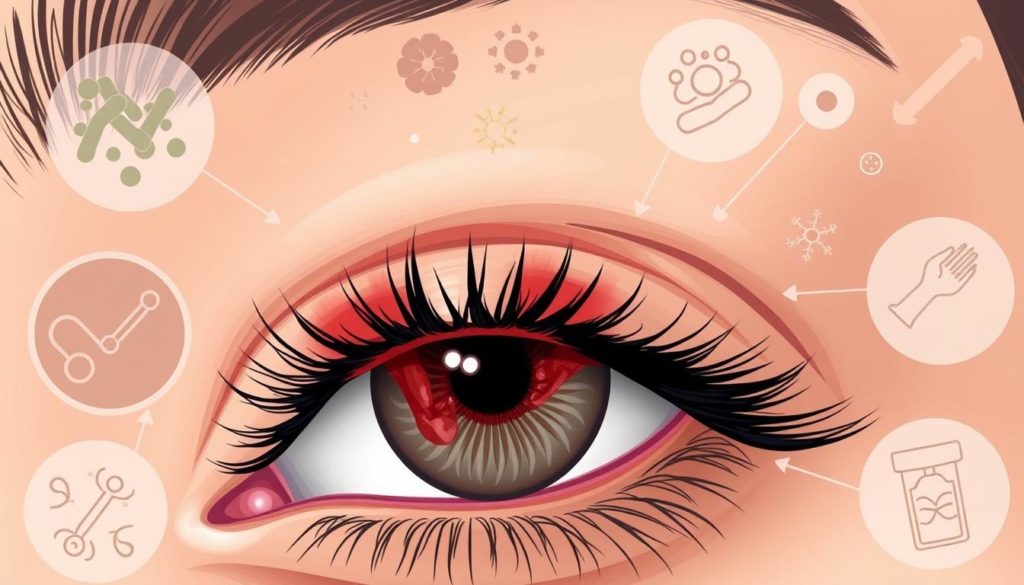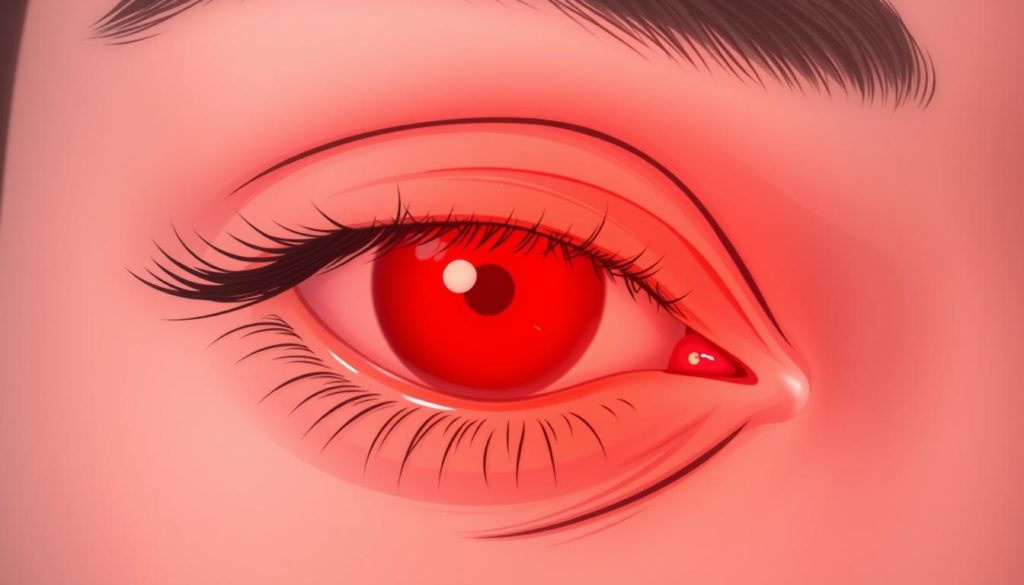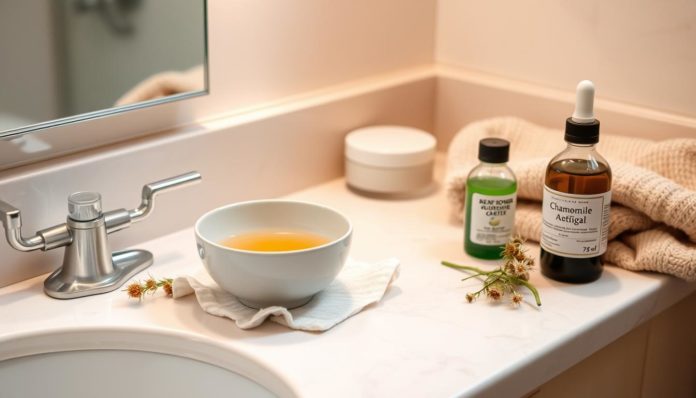Did you know that nearly 80% of people will get a stye at some point? This common eye problem is usually not serious but can hurt a lot. The good news is you can treat it well if you understand how.
A stye is a red, painful lump near your eyelid. It happens because of a bacterial infection. It’s important to handle a stye carefully to not spread the infection or cause more problems. This guide will show you how to treat styes safely.
We will go over causes, symptoms, immediate steps, and home treatments. Let’s start and see how you can cure a stye safely and effectively.
Understanding What Causes a Stye
A stye, or hordeolum, is commonly caused by bacteria and lack of cleanliness. Knowing why they happen can help stop and treat this annoying issue.
Bacterial Infections
Staphylococcus aureus bacteria often cause styes. They infect your eyelid’s oil glands, causing painful, swollen bumps. Bacteria from your skin or hands can touch your eye, leading to infection.
Poor Hygiene
Poor hygiene practices also lead to styes. Not washing hands before touching your eyes, improper contact lens cleaning, or leaving makeup on can cause them. These habits let bacteria and other harmful agents in, risking eye infections.

Avoid styes by knowing these causes and keeping clean. Wash hands often, care for your eyelids properly, and keep your eye area clean. These steps can hugely lower your stye risk.
Types of Styes and Their Symptoms
Dealing with a stye can be a real bother. Knowing the various types of styes and spotting the signs early can help a lot. This will make managing and treating them more effective.

We mainly have two types of styes:
- External Styes: These form along the eyelid’s edge. They often resemble small pimples or boils. Signs include redness, soreness, and swelling. A yellow, pus-filled center is also common.
- Internal Styes: These styes develop inside the eyelid, making them more painful than external ones. They lead to a red, swollen area that’s tender when touched.
To better understand and compare stye symptoms, let’s check out a table:
| Type of Stye | Location | Common Symptoms | Pain Level |
|---|---|---|---|
| External Styes | Edge of Eyelid | Redness, Swelling, Pus-filled Bump | Moderate |
| Internal Styes | Inside Eyelid | Swelling, Tenderness, Redness | High |
Whether it’s an external or internal stye, spotting the symptoms early is key. Regular hygiene and quick actions are the best way to fight styes.
Immediate Steps to Take When You Notice a Stye
It’s important to act fast when you spot a stye. Quick actions can help avoid more problems and speed up healing.
Maintaining Cleanliness
First, ensure you keep everything clean. Wash your hands before touching your eyes to prevent spreading germs. Also, use a gentle cleaner on the stye area to stop bacteria from growing.
Warm Compress
Using a warm compress helps with styes. It boosts blood flow and aids in draining the stye. Here’s an easy way to use it:
- Soak a clean cloth in warm water.
- Make sure it’s warm, not hot, after wringing it out.
- Hold the cloth on the stye for 10-15 minutes.
- Do this 3-4 times a day to help with drainage and comfort.
By following these steps right away, you’ll increase your chances for fast relief. Don’t try to pop or squeeze the stye as it could make the infection worse.
Effective Home Remedies for Styes
Finding the right home remedies for styes can be very helpful. It can make you feel better faster. Using natural methods, you can deal with this annoying issue well.
Warm Compress
A warm compress is quite simple but works wonders for styes. It improves blood flow to the stye, helping it heal quicker. Here is what to do:
- Soak a clean cloth in warm water.
- Wring out the extra water.
- Place the warm cloth on your closed eyelid gently.
- Keep it there for around 5-10 minutes.
Do this many times a day for great results.
Green Tea Bags
Green tea bags are another top choice for a natural solution. They have antioxidants and reduce swelling and discomfort. Here’s the right way:
- Make a cup of green tea and let the bag steep.
- Take the bag out and let it cool until it’s warm.
- Put the warm tea bag on your closed eyelid for about 5 minutes.
Green tea is also good for your eyes in general.
Aloe Vera
Aloe vera is famous for calming and reducing inflammation. It’s great for treating styes. How to apply aloe vera:
- Slice a fresh aloe vera leaf to get the gel.
- Put the gel on the stye with a clean finger or cotton swab.
- Leave it for about 20 minutes then wash off with warm water.
Repeat a few times daily to lessen pain and speed healing.
Over-the-Counter Treatments for Stye Relief
Dealing with a stye can be uncomfortable. Luckily, over-the-counter options can help. This includes treatments found at your pharmacy that ease symptoms and speed up healing.
Antibiotic Ointments
For fighting bacteria, antibiotic ointments work well. Products like Neosporin or Polysporin can be gently applied. Doing so helps cut down on infection risks and promotes healing.
Pain Relievers
It’s important to manage a stye’s discomfort. Pain relievers like ibuprofen or acetaminophen help. They reduce both pain and swelling, making you feel better.
| Treatment Type | Examples | Purpose |
|---|---|---|
| Antibiotic Ointments | Neosporin, Polysporin | Prevent bacterial growth, promote healing |
| Pain Relievers | Ibuprofen, Acetaminophen | Reduce pain and inflammation |
When to Seek Professional Medical Help
It’s crucial to know when to get professional help for a stye. This helps prevent further issues and makes sure the stye is treated right. While you can take care of most styes at home, sometimes you need a professional.
Persistent Stye
If a stye doesn’t go away after a week, even with home treatments, see a healthcare provider. A stye that won’t go away might point to a deeper issue that only a professional can diagnose and treat.
Severe Pain or Swelling
Severe pain or a lot of swelling around the eyelid is a warning sign. It could mean there’s a serious infection that needs quick medical care. Eye care specialists have the right medicine and methods to treat a stye properly, making sure your eye health stays safe.
Getting Rid of a Stye Safely
Having a stye can be tough, but using safe stye removal steps is key. Make sure not to squeeze or pop the stye. Doing so can make the infection worse and cause more problems.
To deal with a stye properly, start by cleaning the area and using a warm compress. Doing this several times a day helps drain it naturally and eases the pain. Also, don’t wear makeup or contacts until the stye is gone to avoid more irritation.
- Warm Compress: Apply for about 10-15 minutes, 3-4 times daily.
- Maintain Cleanliness: Wash your hands before touching your eyes and gently cleanse the eyelid with a mild soap.
- Avoid Squeezing: Never attempt to pop the stye, as this can lead to serious complications.
Knowing when to get help from a doctor is also vital. If your stye doesn’t get better, hurts a lot, or swells up, see an eye doctor. This step keeps the infection from getting worse and helps ensure safe stye removal.
| Technique | Function | Frequency |
|---|---|---|
| Warm Compress | Promotes drainage and relieves pain | 3-4 times daily |
| Cleaning Eyelid | Reduces bacteria and prevents re-infection | Once or twice daily |
| Avoid Squeezing | Prevents aggravation and spreading of infection | Always |
With these tips, you can handle styes effectively and safely. A gentle approach helps you heal faster and safer. Remember, eyes are sensitive. Treating them with care is very important.
Precautions to Take to Avoid Spreading the Infection
To control stye infection and stop it from spreading, certain steps are necessary. Here are crucial actions you can take:
Avoid Touching the Stye
Avoiding the stye is vital in preventing its spread. Touching it could make the infection worse. This could also increase the risk of spreading bacteria. It’s also key to not rub your eyes to avoid making things worse.
Use Separate Towels and Linens
Using separate towels and linens is important for stye control. This prevents cross-contamination. Sharing towels could easily spread it to others in your house. Below is a comparison showing how different hygiene habits help prevent stye spread:
| Hygiene Practice | Effectiveness in Preventing Stye Spread |
|---|---|
| Sharing Towels | Low |
| Using Separate Towels | High |
| Frequent Hand Washing | High |
| Avoiding Eye Contact | Moderate |
How to Properly Apply Warm Compresses
Using warm compresses is a great way to help with a stye. They can make the swelling go down and help it heal faster. Let’s look at how often to use them and for how long.
Frequency and Duration
To see good results, it’s important to know when and how long to apply the compress. Here are some tips:
- Frequency: Put the compress on your eye at least four times every day. This helps keep the right amount of warmth and helps drainage.
- Duration: Keep the compress on for 10 to 15 minutes. This is enough time to soften the stye but not irritate your eye.
Proper Technique
How you apply the stye compress matters a lot for its effectiveness. Here’s what you should do:
- Heat the Compress: Dip a clean, soft cloth in warm water. Make sure the water is not too hot to avoid burns.
- Apply to the Stye: Carefully place the warm cloth over the stye. It should comfortably cover the whole area.
- Reheat if Necessary: The compress might get cool while you’re using it. If it does, warm it up again before the time is up.
- Cleanliness: Use a fresh cloth every time to avoid spreading bacteria.
Warm compresses are really helpful if you use them regularly. Remember, using the right technique is just as important as how often and how long you apply them.
Stye Prevention Tips for the Future
To keep your eyes healthy, preventing styes is key. Adopting certain hygiene practices helps a lot. By careful handling of personal items, you can cut down on the risk of these annoying infections. Here are some powerful stye prevention tips to promote eye health.
Personal Hygiene
Good personal hygiene is vital for avoiding styes. Wash your hands often, especially before touching your eyes or contact lenses. This keeps harmful bacteria away. Also, fully remove your makeup every night to prevent clogging your eyelids’ oil glands. Gently clean your eyelids with a mild soap or special cleanser to keep residue and debris that might cause styes away.
Avoid Sharing Personal Items
To protect your eye health, don’t share personal eye items. Makeup, face towels, and pillowcases can spread bacteria, leading to stye infections. Use only your makeup and wash anything that touches your face often. This way, you lower the chance of spreading bacteria and getting a stye.
FAQ
What is a stye and how can I treat it safely?
A stye is a red, painful lump near your eyelid’s edge, caused by bacteria. Keep the area clean and use warm compresses. Try using green tea bags and aloe vera for their healing effects.
What causes styes?
Styes come from bacterial infections, mostly by Staphylococcus aureus. Not washing hands and touching your eyes can spread bacteria, leading to styes.
What are the symptoms of a stye?
A stye causes redness, swelling, pain, and a pus bump on the eyelid. They can appear on the edge or inside the eyelid.
What immediate steps should I take when I notice a stye?
Keep your eye clean and apply a warm compress as soon as you see a stye. It reduces symptoms and helps the stye drain.
What are some effective home remedies for styes?
Warm compresses, green tea bags, and aloe vera are great home remedies. They reduce pain and speed up the healing process.
Are there over-the-counter treatments for styes?
Yes, antibiotic ointments can stop bacteria, and pain relievers ease stye discomfort. These options are available without a prescription.
When should I seek professional medical help for a stye?
If your stye gets worse, doesn’t improve, or if you have lots of pain or swelling, see a doctor. This might mean there are complications.
How can I safely get rid of a stye?
To remove a stye safely, keep your eye clean and use warm compresses. Don’t try to pop or squeeze the stye.
What precautions should I take to avoid spreading the infection?
Avoid touching the stye too much. Use your own towels and linens to stop the spread of infection to others at home.
How should I properly apply warm compresses to a stye?
Put warm compresses on the stye several times a day for 10-15 minutes. Use a clean, warm cloth and be gentle.
How can I prevent styes in the future?
Prevent styes by washing your hands often, not touching your eyes, and not sharing make-up or towels. Keep your eye care products clean.


